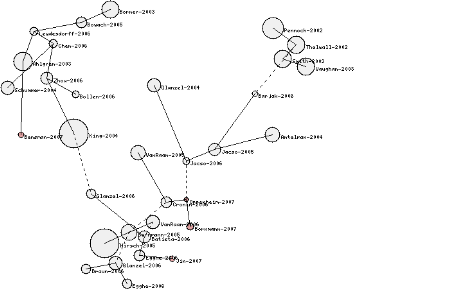New to AcademicProductivity.com?
Here are a few posts that other readers recommend you check out:
[dismiss]
Maybe I’m getting out of touch, but it’s only now that I found sciencewatch. It’s a service of Thomson Reuters (the makers of Web of Science) that collects and displays statistics on recent trends in science. Example:
Aug 2008 – SCHOLARLY USE OF THE WORLD WIDE WEB – Research Front Map – ScienceWatch.com
This is a citation network that shows highly cited papers on WWW. Diameter relates to citation: the two bigger circles are the paper that proposed the Hirsch index, and King’s paper on the scientific impact of nations. Clicking on the circles provides details on the papers.
There are many other fronts:
-
Fast Breaking papers. These papers comprise the top 1% of papers in each field and each year
-
Top Topics selects the Research Fronts with the largest absolute increase in size in each of the 22 major fields covered by Essential Science Indicators
Worth keeping an eye on.
If you enjoyed this post, make sure you !
[how to cite this post]
[hide]
AMA citation:
Quesada J. ScienceWatch.com: an interesting way to see trends in science. Academic Productivity. 2009. Available at: https://academicproductivity.com/2009/sciencewatch-com-an-interesting-way-to-see-trends-in-science/. Accessed September 1, 2011.
APA citation:
Quesada, Jose. (2009). ScienceWatch.com: an interesting way to see trends in science. Retrieved September 1, 2011, from Academic Productivity Web site: https://academicproductivity.com/2009/sciencewatch-com-an-interesting-way-to-see-trends-in-science/
Chicago citation:
Quesada, Jose. 2009. ScienceWatch.com: an interesting way to see trends in science. Academic Productivity. https://academicproductivity.com/2009/sciencewatch-com-an-interesting-way-to-see-trends-in-science/ (accessed September 1, 2011).
Harvard citation:
Quesada, J 2009, ScienceWatch.com: an interesting way to see trends in science, Academic Productivity. Retrieved September 1, 2011, from
MLA citation:
Quesada, Jose. "ScienceWatch.com: an interesting way to see trends in science." 6 Jul. 2009. Academic Productivity. Accessed 1 Sep. 2011.
This entry was posted on Monday, July 6th, 2009 at 12:13 pm and is filed under News, Reading, Reference management, Web 2.0. You can follow any responses to this entry through the feed. You can leave a response, or trackback from your own site.

August 10th, 2009 at 2:50 am
“This is a citation network that shows highly cited papers on http://WWW.â€
Good thing I stumbled into this fine article about the scholarly use of the web in relation to science. Will surely make some use for it in the future.
August 10th, 2009 at 11:45 pm
“Maybe I’m getting out of touch, but it’s only now that I found sciencewatch. It’s a service of Thomson Reuters (the makers of Web of Science) that collects and displays statistics on recent trends in science.â€
This helps us in foreseeing the advancements to come, provided the stats are consistent. Actually, there are other online tools you can use aside from sciencewatch.
August 11th, 2009 at 4:07 am
This diagram only shows how each scientific work or research is done to improve the field further. How would this process affect research 20 years from now? How much knowledge now needs to be taught to children with the fast development of information? Will this bring new citation rules to the ones already followed?